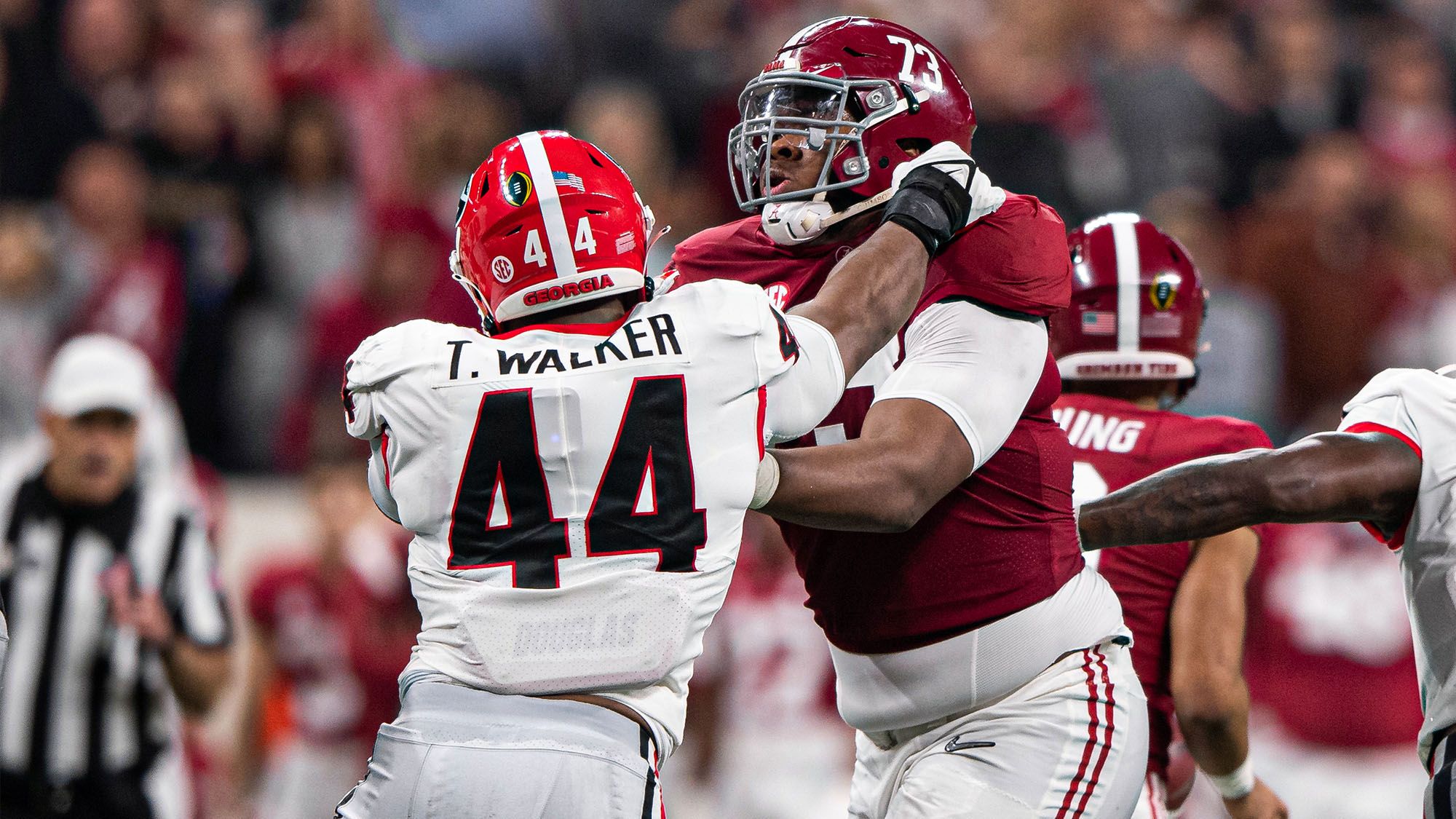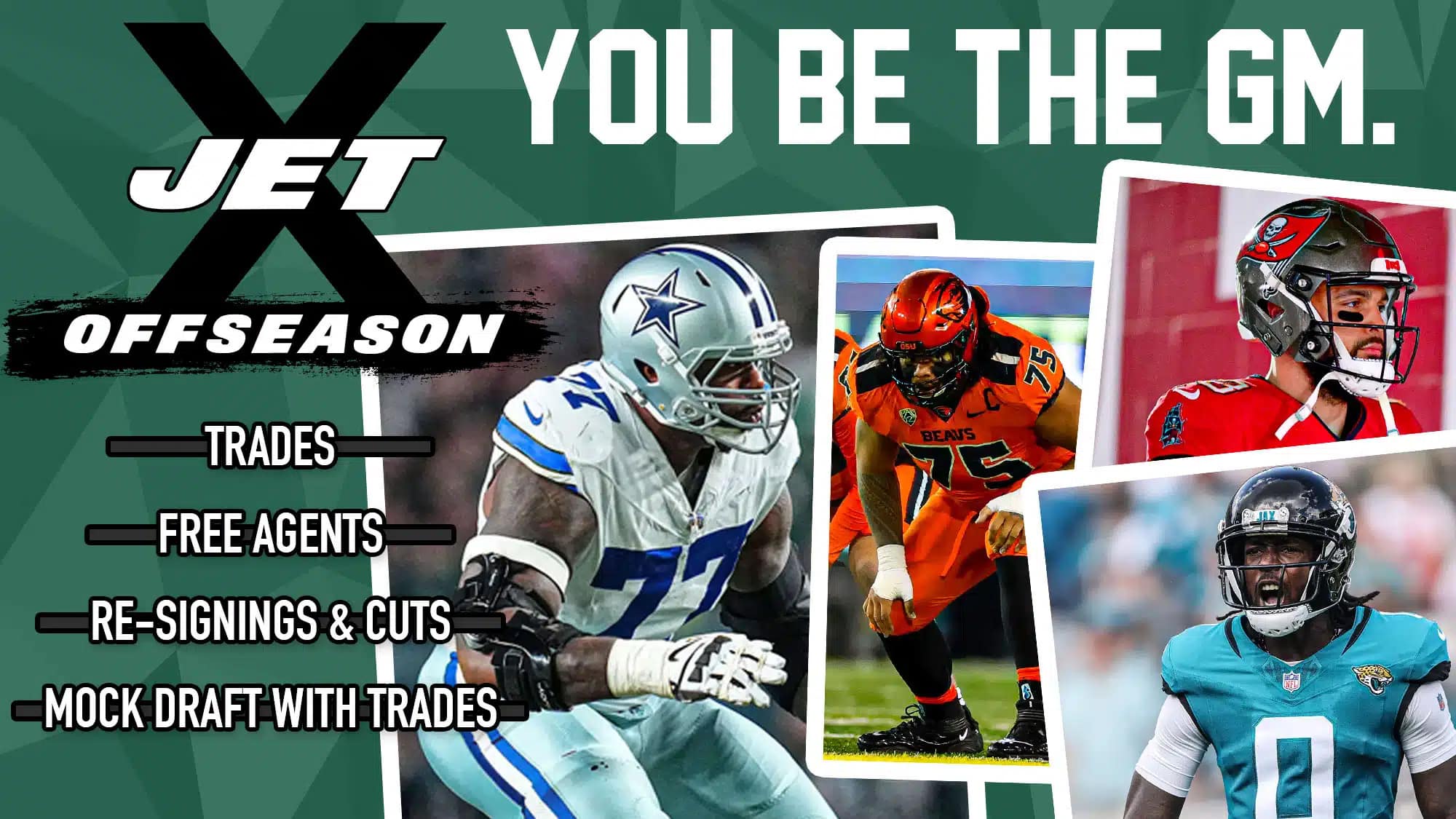Analyzing New York Jets GM Joe Douglas’ valuation of collegiate production in the NFL draft
One of the greatest dilemmas during the NFL draft evaluation process is the question of how much we should value a player’s collegiate production. Does it matter how good a player was in college?
Nearly every NFL prospect was a good-to-great college player at the very least. That makes it difficult for evaluators to compare prospects’ production levels against one another.
However, there is still a spectrum when it comes to the production of NFL draft prospects. Yes, most players were impressive, but some players achieved higher degrees of dominance than others.
Take a look at the 2022 draft’s EDGE class, for example. Aidan Hutchinson and Kayvon Thibodeaux were overwhelming forces who caused havoc at otherworldly rates of efficiency. Conversely, while Travon Walker was a good player at Georgia, he was nowhere near a star-caliber producer.
Yet, Walker has an outside chance to be drafted earlier than both Hutchinson and Thibodeaux.
This is because teams don’t make selections based on what the prospect has done. Teams make their picks based on what they think the prospect will do. For this reason, prospects like Walker constantly get taken ahead of prospects who performed better in college.
I was curious to find out which type of prospect has been preferred by the New York Jets and general manager Joe Douglas. Has Douglas preferred players with excellent collegiate production or is he okay with taking players who were not superstars in college?
To answer that question, I analyzed every prospect taken in the 2020 and 2021 NFL drafts (save for kickers, punters, and long snappers) and recorded their overall Pro Football Focus grade from the final season they played in college. I then agglomerated the grades of each teams’ picks to arrive at an average PFF grade for their non-specialist picks from 2020 to 2021.
PFF grades are a good tool for this exercise since they allow us to compare players at all positions on the same plane. Calculated through the grading of every snap, a player’s PFF grade is a 0-to-100 score that estimates his overall performance level. It gives us a solid indication of how good the player was in college.
Without further ado, here is a look at the average collegiate PFF grades of each team’s draft picks from 2020 to 2021.
| 2020-21 | Avg PFF Grade |
|---|---|
| MIA | 80.8 |
| DET | 80.5 |
| CIN | 80.1 |
| WAS | 79.9 |
| TEN | 79.8 |
| SFO | 79.2 |
| CHI | 79.1 |
| TAM | 79.1 |
| PHI | 78.8 |
| IND | 78.7 |
| BAL | 78.5 |
| NYJ | 78.4 |
| PIT | 78.3 |
| NOR | 78.0 |
| CLE | 77.8 |
| DAL | 77.4 |
| NWE | 77.4 |
| ATL | 77.4 |
| KAN | 77.2 |
| NFL Avg | 76.9 |
| ARI | 76.5 |
| CAR | 76.4 |
| SEA | 75.8 |
| HOU | 75.7 |
| LVR | 75.6 |
| MIN | 74.6 |
| JAX | 74.5 |
| LAR | 74.5 |
| BUF | 74.2 |
| LAC | 73.4 |
| GNB | 72.6 |
| NYG | 72.5 |
| DEN | 71.4 |
With their draft picks boasting an average final-college-season PFF grade of 78.4, the Jets rank 12th out of 32 teams in this category over the past two years. That’s a bit higher than the NFL average of 76.9. This suggests that Douglas and the Jets do tend to value collegiate production a tad more than the average NFL team.
Play: 👉 the Jet X Offseason Simulator
New York actually landed at two very different parts of the leaderboard in each of the past two drafts. Douglas and the Jets dramatically changed their strategy in this category between 2020 and 2021.
Here’s a look at how the league stacked up in 2020.
| 2020 | Avg PFF Grade |
|---|---|
| BUF | 85.2 |
| DAL | 83.6 |
| CIN | 82.7 |
| KAN | 81.7 |
| TAM | 81.7 |
| DET | 81.3 |
| IND | 81.2 |
| NOR | 81.2 |
| MIA | 81.0 |
| BAL | 80.9 |
| WAS | 79.9 |
| ARI | 79.7 |
| CAR | 79.3 |
| CLE | 79.2 |
| ATL | 78.5 |
| TEN | 78.3 |
| SFO | 78.3 |
| PIT | 78.2 |
| LVR | 77.8 |
| LAR | 77.2 |
| HOU | 77.2 |
| MIN | 76.9 |
| NWE | 76.7 |
| NYJ | 76.4 |
| SEA | 75.8 |
| JAX | 75.2 |
| GNB | 74.9 |
| CHI | 74.3 |
| LAC | 74.2 |
| PHI | 74.1 |
| NYG | 69.1 |
| DEN | 65.6 |
In 2020, the Jets opted for potential over production. Their draft picks had an average PFF grade of 76.4, ranking 24th.
New York’s first two picks were effective producers: Mekhi Becton (83.0) and Denzel Mims (81.9). But after that, only one of the Jets’ next six non-specialist selections had a grade of 80.0+ (Jabari Zuniga, 87.5). Players like Ashtyn Davis (72.2), La’Mical Perine (75.4), and James Morgan (66.4) were upside-based picks who didn’t offer tantalizing collegiate production.
After the Jets overhauled their coaching staff in the 2021 offseason, the team operated with a much different approach in regards to their valuation of collegiate production.
Here is how the league stacked up in 2021.
| 2021 | Avg PFF Grade |
|---|---|
| PHI | 84.2 |
| CHI | 84.0 |
| TEN | 80.9 |
| MIA | 80.7 |
| NYJ | 80.0 |
| WAS | 79.8 |
| SFO | 79.8 |
| DET | 79.5 |
| PIT | 78.4 |
| NYG | 78.3 |
| NWE | 78.2 |
| CIN | 78.0 |
| DEN | 77.3 |
| ATL | 76.7 |
| TAM | 76.6 |
| CLE | 76.5 |
| NOR | 75.9 |
| SEA | 75.8 |
| BAL | 75.4 |
| IND | 74.8 |
| CAR | 74.3 |
| HOU | 74.2 |
| ARI | 73.8 |
| JAX | 73.6 |
| DAL | 73.5 |
| KAN | 73.4 |
| LVR | 73.4 |
| LAC | 72.9 |
| LAR | 71.7 |
| MIN | 71.3 |
| GNB | 70.3 |
| BUF | 66.1 |
In 2021, the Jets strongly leaned towards prospects who played at a top-tier level in college. Their picks had an average PFF grade of 80.0, ranking fifth-highest.
Douglas was particularly keen on production with his first four picks of the draft, which were each used on offensive players. Zach Wilson (95.4), Alijah Vera-Tucker (81.8), Elijah Moore (91.2), and Michael Carter (91.7) were all dominant in college, combining for an average PFF grade of 90.0 in 2021.
It’s extremely early, but the Jets’ 2021 class is looking much better than their 2020 class, so perhaps they decide to stick with the production-favoring strategy they adopted last year.
If this trend continues, here are some highly-graded 2022 prospects that Douglas could target in the top-10 of the draft:
- Aidan Hutchinson, EDGE, Michigan: 94.5
- Ikem Ekwonu, OT, NC State: 91.6
- Drake London, WR, USC: 91.3
- George Karlaftis, EDGE, Purdue: 87.2
- Ahmad Gardner, CB, Cincinnati: 87.1
- Evan Neal, OT, Alabama: 85.8
- Garrett Wilson, WR, Ohio State: 84.1
- Kayvon Thibodeaux, EDGE, Oregon: 83.2
- Jermaine Johnson, EDGE, Florida State: 82.3
- Jameson Williams, WR, Alabama: 81.6
Chris Olave (79.7), Kyle Hamilton (76.1), Travon Walker (70.8), and Derek Stingley (66.6) are some potential first-round targets for the Jets who possess grades that are noticeably lower than Douglas’ early 2021 picks.


